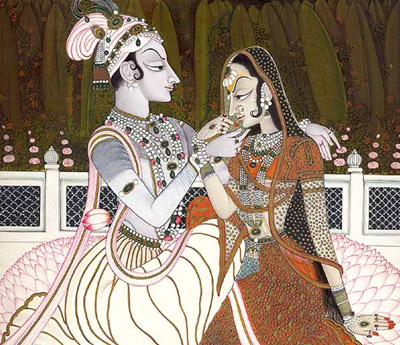
The name “pearl” supposedly comes from Chinese word “jhen-gzhū” through “zengug”.
According to ancient Chinese legend, when dragons were fighting amongst the clouds during storm, pearls came from the sky with raindrops. Dragons and pearls are closely connected in China.
The birth of pearls is surrounded by legends. According to ancient Greeks, they were the tears of a sea nymph. Ancient Slavs considered it to be a stark reflection of a lightning in the eyes of a mollusk. Chinese believed it to be a petrified moon light in the water.
Even today, when most of the secrets of pearl origins have been discovered, the “living stone” keeps its secret. Pearl is the most mysterious and amazing stone of all gem stones. It is a personification of femininity and tenderness. This is the only stone in jewellery used without any special treatment.
Delicate play of colours and a mysterious inner glow draw attention to it from ancient times. These very qualities along with spherical or regular pear-shape have brought world wide fame to pearls. Its whiteness and iridescent chatoyant glow made it a symbol of purity.
Though, pearls can not be described, it is possible to long to have them. From the ancient times, it has been considered to be the most valuable and wanted treasure, which is why pearls were the indispensable attribute of monarchs, they were cherished in queens’ and fashionmongers’ bosoms, and also they were widely used in incrustations of crowns, rings, beads, ear-rings, belts, buckles and chests with treasures of millions of people.
The oldest surviving record about pearls is commonly considered to be the following sentence from the history of the king Shu: «In 2206 (AC) the king Ju received pearls as a levy from the river Hwai…». 42 centuries ago in China, pearls were considered to be an attribute of Table of ranks: emperor’s court nobility were distinguished by a bead of nephrite, turquoise or coral, while the highest court official wore a pearl on his hat.
Pearls are mentioned in Old Testament, Talmud and Koran.
Indian, Persian and Arabian kings were fighting for dearth to control pearl beds, one of the largest of which was situated in the Gulf of Mannar. Being under control of Persian and Arabian kings up to the 16th century, this area was a source of national prosperity and power. After that for about a century this region was under the rule of Portuguese, but only up to the moment of the stormy return of Persians, who have re-taken the place of the best pearl divers in the world.
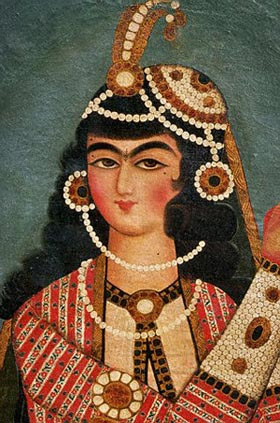
Seven pearl flowers with long stems were found in one of the burial places dated the middle of the third millennium in Mesopotamia, between the rivers Tigris and Euphrates. The symbolism of the details was meant to protect human from various misfortunes.
The crown of Shahanshahs of Iran of the House of Pahlavi contains 3 380 diamonds, 369 pearls and five emeralds of 60 to 100 carat each.
Central America was very famous for its pearls. Spanish conquerors found thousands of giant idols, which were covered with pearls, in the place of the current location of Mexico. Peals were even used to decorate walls and ceilings of majestic temples, sculptures and other cultural pieces. The conquerors frequently found secret rooms in temples, which were full of silvery semi-precious stones.
НThere is no other place in the world, where fashion for precious stones would be as stable, as it is in India. English traveler T. Rowe wrote the following, describing jewelry, which in 1616 wore Indian emperor Jahangar on the occasion of his passage to other town: “He wore a splendid turban on his head with luxuriant feathers of heron; there was an unmounted ruby as big as a nut hanged on the one side, and a diamond of equal size on the other, in the middle there was an emerald in the shape of a heart, but larger, than the first ones. The belt was interwoven with a fine pearl bead with rubies and perforated diamonds; a bead of the most valuable double pearls that I have ever seen was on his neck…In one of the privy rooms of the empress Vidžajanagara stood a bed with inch wide pearl bars..
Phoenicians were the first to become interested in pearls among Mediterranean nations. Homer described that in his famous epics of the 8 century AC. «A couple of pearls as if twisted from mulberries» were granted to Penelope in the poem “Odysseus” by Homer. In fact, pearls conquered Europe with Alexander the Great, who united East and West and opened the way for trade, manufacturing and cultural development.
On the recommendation of the Greek philosopher Aristotle, before attacking India, Alexander the Great conquered the island of Socotra, which was famous for its beautiful black pearls. The commander was fascinated by the black pearls and, joining them with dazzling white and slightly rose ones, he sent them to Greece. The rage for similar collections started at once.
When this area was conquered by the Romans, they fell wantonly in love with pearls. Pearl in Latin is “margarite” and initially Romans called something beloved with this word. The best pearls in Rome were called “unio”, which means “something unique”.
Pearl essence enabled once Egyptian queen Cleopatra and her beloved Mark Antony to regale with the most expensive supper in the world. Cunning Cleopatra ordered a usual royal supper, yet preliminarily she made a bet with Mark Antony for a supper at the cost of several millions. The feast was coming to an end and Mark Antony was ready to celebrate his victory, when a bocal of vinegar was served to Cleopatra; she put her ear-ring with a large pearl in it, took a sip and looked at Antony with triumph. Italian painter Tintoretto devoted his famous painting to this episode
Such virtue as restraint is hardly associated with life in Ancient Rome, so passion for pearls took the form of ferity as well. Dandy kings used pearls to decorate the most unexpected parts of their bodies, used it in intricate drapery of their clothes, their magnificent costumes and splendid accessories. No wonder that Cesar, Nero and Caligula were ardent admirers of pearls.
It is recorded that Julius Cesar presented to Mark Brutus’s mother a pearl of more than one million two-hundred thousand francs in the value. Emperor Aurelius decorated a diadem with pearls, which, after it became a crown, was completed with a number of pendants, stud with pearls and precious stones, which lowered over the ears. Even in those ancient times the newly-married were tied together with pearl necklace, which was a symbol of marital fidelity.
The wife of Emperor Caligula wore a pearl necklace of more than eight millions in the value. According to George Kunz, Caligula put a pearl bead on the neck of his favourite horse after he proclaimed it a consul.
Roman emperors preferred to decorate with pearls not only their clothes, but also their shoes, furniture and other things.
The Romans were so much in love with pearls that, according to historicists, they exchanged gold to pearls, so that balance of trade of Rome was seriously damaged.
Yet, when Rome was pillaged by Goths and Vandals, the pearls from Roman treasuries were lost. Having lost their value for a long period of time, pearls, nevertheless, managed to assert themselves in Catholic art and architecture. Symbolizing love for God, pearls were used in canonical dresses, altars and other religious attributes.
Throughout most of the early Middle Ages the spread of pearls encountered a number of obstacles. The situation has changed only after the moment, when crusaders began to return from the Holy Land in XII – XIII centuries. This was the moment, when knighthood began to flourish and spread in many European countries. The fashion for wearing pearls reappeared as well.
The high and mighties were served with beverages in pearl cups or pearls inside wine, like it was done for the king in Shakespeare’s tragedy “Hamlet”. «The king shall drink to Hamlet's better breath, and in the cup an union shall he throw, richer than that which four successive kings in Denmark's crown have worn.» .
Renaissance favored renewed interest to pearls and a desire to obtain it as a personal jewelry. This was due to the fact that Renaissance itself was a period of abundance and high creative mastery flourishing.
Christopher Columbus not only discovered America, but during his third journey, he brought to the Old World the bags full of pearls, which he bartered alongshore of Venezuela. Later Panama and Gulf of California also became pearl beds, while French, Italians, Austrians and English rushed to purchase pearls, lots of pearls.
On the occasion of christening of the future king, the son of Louis XIII, Marie de’ Medici wore a dress, which was decorated with three thousand diamonds and thirty thousand pearls.
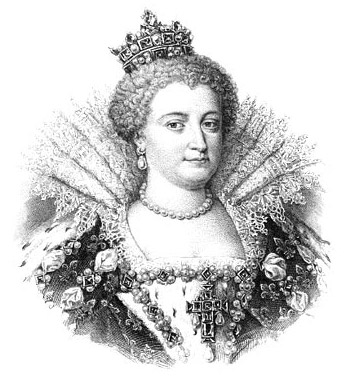
In XVI century the best pearls in Europe were considered to be the pearls from the dowry of the French queen Catherine de’ Medici. After her wedding, she presented them to the Scottish queen Mary Stuart, while later they became a property of English queen Catherine I.
Yet, supposedly, they were all surpassed by the English queen Elizabeth I, who had such passion for pearls, that she almost always wore more than seven pearl beads, some of which reached the knees. Queen Elizabeth was also an honorable owner of a dress, decorated with three thousand pearls.
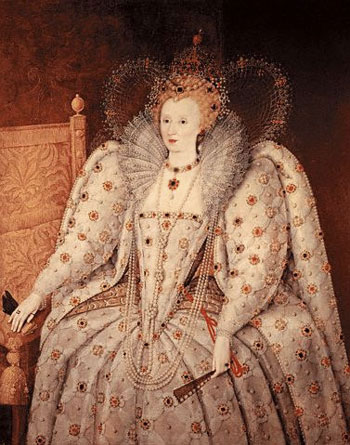
In 1579 Spanish king Philip II received from Margarita Island in the Caribbean Sea (the name of the island comes from marguerites – the pearls, which were in abundance around the island) an astonishing white pearl called “La Perigrina”, which was as large as a pigeon’s egg, with perfect pear shape and incomparable pearl luster. The king paid 100 000 francs for it. Afterwards Spanish conquistador Núñez presented the gem to the English queen Mary Tudor. Yet, after the death of the queen, the pearl returned to Spain, though in 1813 it was again carried away by the king Joseph Bonaparte. After that, the pearl was a property of the king of Holland Louis Bonaparte for some time, but later it was purchased by English lord Hamilton, who granted it to his beautiful wife. Nowadays “La Perigrina” is in Spain again. Its sphericity is so ideal, that it would roll down from every surface even when slightly bended, which is why it is called “La Perigrina”, which means “the pilgrim”.
French royal house owns a famous pearl “La Regente”, which is «of excellent iridescence and first water», as large as a pigeon’s egg, along with more than 400 pearls of the highest quality of 320 carat grain each. All these jewels belonged to French empress Eugene, the wife of Napoleon III.
In the Tower of London, the ancient residence of the British kings, the Imperial State Crown is kept, which contains 34 gems, 277 pearls and no less than 300 diamonds.
Pearls were usually a property of the members of the European reigning families. Yet, changes in social structure of rich people influenced social composition of the owners of pearls. The inhabitants of the early American colonies had less pearls than the Europeans. Though, shortly after, this situation has changed. By the middle of XIX century diamonds were considered to be a sign of prosperity, yet the ladies of highest degree had at least one high-quality pearl bead. By the 1890-s it was fashionable to look luxurious, which boosted popularity of pearls. At first, the owners of pearls were not the jewelry houses, but single men of means, like William Vanderbilt, who brought famous pearl beads and granted them to their wives and daughters. At the turning point of XIX – XX cc rich European women competed for the right to have the largest collection of pearls.
It is wonderful that remaining a classic gem, it would never be out of fashion. “Pearl is always right”, - said Coco Chanel, who made pearls the most versatile jewelry, which suits to every woman and every clothes.
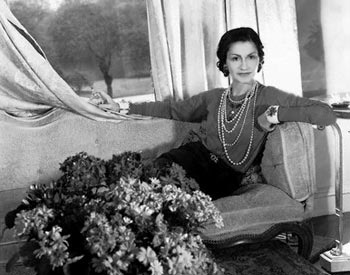
She was the first to approve the combination of white pearls with black sweater, dark elegant jacket and little black dress. Chanel considered pearls to be her favorites of her collections and wore several pearl beads at a time. Her trademark is long pearl bead reaching the stomach level. Now, thanks to Coco Chanel’s good graces, pearls became indispensable attribute to both business suit and evening dress.
